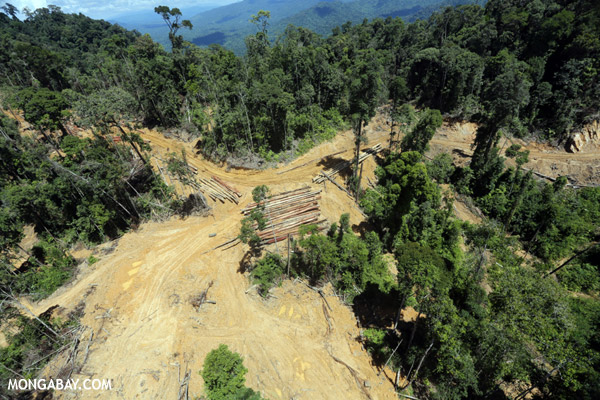
Logging in Malaysian Borneo. Photo by Rhett A. Butler
Five major timber importers are making progress in cutting contraband wood from their markets, argues a series of reports published by Chatham House.
The analysis — which covers Britain, France, Japan, the Netherlands, and the United States — is based on point of origin data for timber imports. For example, countries and states with high risk of illegal logging and timber laundering would hurt an importer’s rating.
Overall the collection of reports estimate that four percent of timber imports by volume are at “high risk of illegality”. It pegs the value of these timber and paper products at $7 billion.
Of the five countries assessed, Japan has the highest proportion of high risk imports, chiefly because of large volumes of trade with China, Russia, and Malaysia — all of which have problems with illegally sourced wood.
Chatham House attributes the decline in suspect timber imports to several factors, including recent legislation passed in the United States (the Lacey Act) and Europe (Forest Law Enforcement Governance and Trade or FLEGT).
“Governments and the private sector in all five consumer countries have made concerted efforts to address the issue of illegal imports of wood-based products, including by passing legislation, implementing public procurement policies, signing up to certification schemes and working in partnership with producer countries. However, all have room for improvement,” said Alison Hoare, senior research fellow at Chatham House, in a statement.
“France has been slow to adopt legislation setting out sanctions for importing illegal products prohibited under the EU Timber Regulation, and concerns have been raised as to whether these will be sufficient to ensure effective enforcement,” Hoare continued. “The allocation of sufficient resources for enforcement of this Regulation will also be crucial, not just in France, but also in the Netherlands and the UK. In Japan, weak voluntary measures limit the government’s ability to eliminate illegal products from the market, while the US could improve the effectiveness of its legislation through better implementation procedures.”
Logging is one of the biggest drivers of deforestation. Logging roads open up previously inaccessible areas to outright clearing, while operations can increase the risk of fire and disease, especially in old-growth forests.





Related articles
Sarawak chief calls state’s logging industry ‘corrupt’
(11/24/2014) In a surprising statement, Sarawak’s new chief minister called the state’s logging sector ‘corrupt’.
FSC passes motion for greater protection of primary forests
(09/12/2014) The Forest Stewardship Council (FSC) has passed a motion to increase protection of old-growth forests.
Canada, Russia, Brazil lead world in old-growth forest loss

(09/05/2014) Every day, the world loses about 50,000 hectares of forest to agricultural clearing, road development, and other human activities, constricting true wilderness into smaller and smaller areas – along with the species that inhabit them. New analysis and maps released this week show these last vestiges are disappearing at a quick pace, with more than 104 million hectares degraded from 2000 to 2013.
Ecologists are underestimating the impacts of rainforest logging

(07/31/2014) Ecologists may be underestimating the impact of logging in old-growth tropical forests by failing to account for subtleties in how different animal groups respond to the intensity of timber extraction, argues a paper published today in the journal Current Biology. The study, led by Zuzana Burivalova of ETH Zurich, is based on a meta-analysis of 48 studies that evaluated the impact of selective logging on mammals, birds, amphibians, and invertebrates in tropical forests.